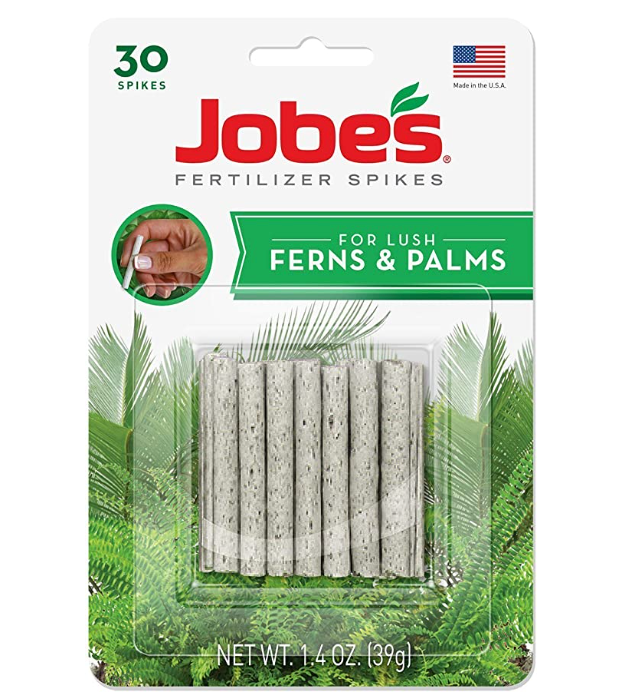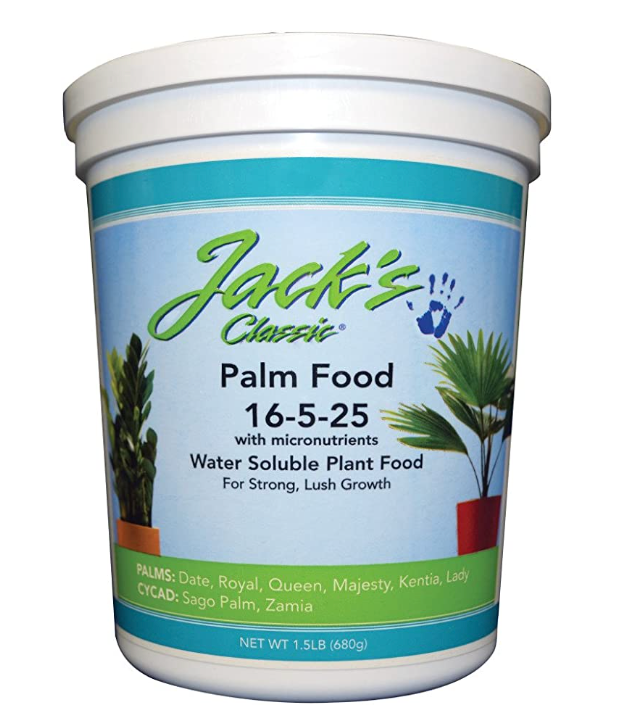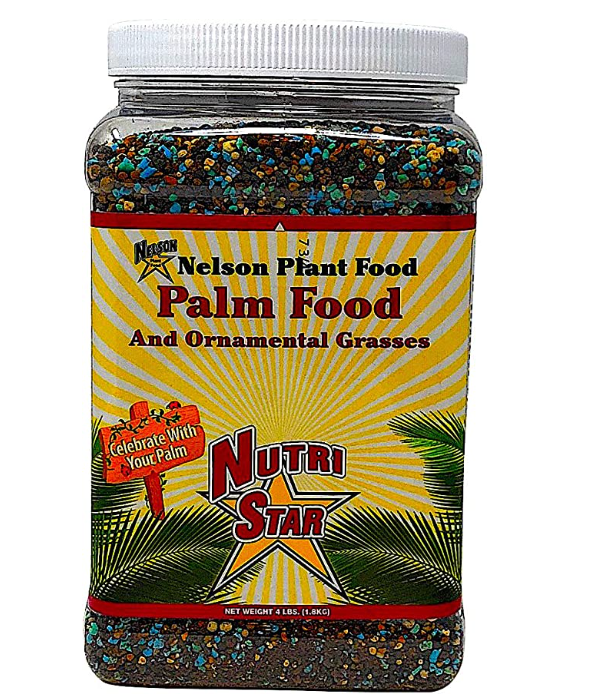9 Best Palm Tree Fertilizers In 2025: Spikes, Liquid and More
by Carl Anderson
Updated on Dec 31, 2024
We rounded up the 10 best fertilizers for palm trees, taking the guesswork out of finding the right nutrients for your beloved palms. From fertilizer spikes to liquid formulas and the crucial NPK ratios, we’ve covered it all to help you pick the best fertilizer for your palm trees.
List of Services
-
Editor's Choice - Miracle Grow Shake N' FeedList Item 1
The Miracle-Gro Shake' N Feed Palm Plant Food is an iron, manganese, and magnesium complex. The nutrients in this palm fertilizer prevent frond curling and leaf yellowing.
-
Best Spikes - Jobe's 10-5-10List Item 2
Jobe's Palm Spikes slow-release fertilizer provides a consistent stream of nutrients to palm trees throughout the year. It comes in a pre-measured quantity in spikes that you can insert around the palm tree's dripline.
-
Best Granular - Jobe's GranularList Item 3
Jobe's Organics granular fertilizer is a fact-acting palm fertilizer that works for all varieties. The fertilizer contains Jobe's Biozome, microorganism archaea that break down materials for quick results.
Miracle Grow Shake N' Feed - The 4.5 lb. bag of Miracle Grow Shake N' Feed contains all the major nutrients your palm trees need with the blessed ease of convenience. Check it out here.
Table of Contents
- The Top 12 Best Palm Tree Fertilizers - Full Analysis (Updated for 2025)
- Best Overall
- Best for the Money
- Best Spikes
- Best Organic
- Best Granular
- Best Water Soluble
- Water Soluble Second Choice
- Best for Palm Trees and More
- Best for Indoor Palms
- Sweet New Earth's Top Pick
- How We Chose The Best Fertilizer
- Liquid
- Water Soluble
- Granular
- Spikes
- FAQs
Things to Consider Before Buying
Liquid
Liquid fertilizers are simple and effective. They come in liquid form, so you don't need to mix or concoct (most of the time), and you can just apply the product directly to the plant. But do they have the specifications you need for your palm trees? Something to consider.
Water soluble
A close cousin to liquid fertilizers, water-soluble fertilizers easily dissolve into water and can be applied quickly to your palm trees. They can be used for most any palm trees but are ideal for those in landscaping. Frequent reapplications are typically needed.
Granular
Granular is what most normal people think of when they think of fertilizer, as they probably remember their dad spreading white pellets across the front yard in hope of a better yield (greener grass). The slower release of granular fertilizers also suits palm trees.
Spikes
Spikes dig around the spot you are trying to fertilize and slowly release nutrients over time. In this case, you would put them around your palm trees and hope for the best. They can have varied results so be sure to make your decision carefully.
The Top 9 Best Palm Tree Fertilizers - Full Analysis (Updated for 2025)
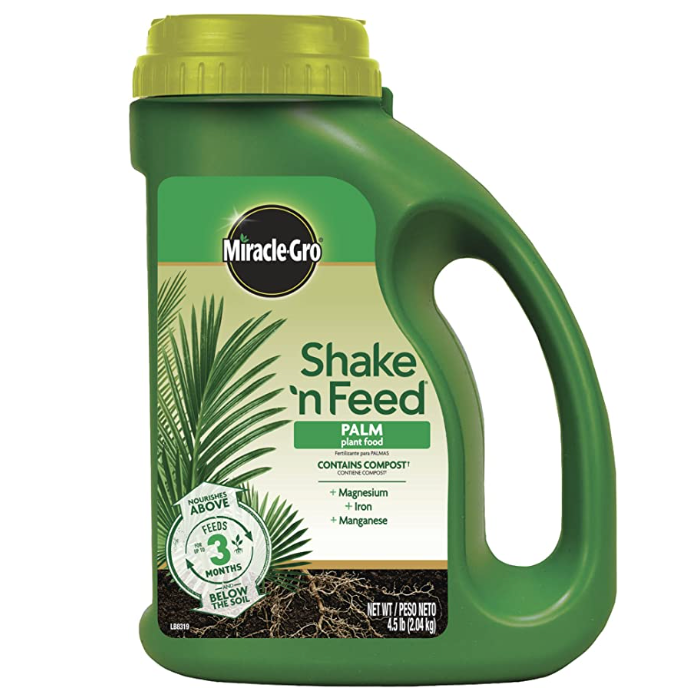
The Miracle-Gro Shake' N Feed Palm Plant Food is an iron, manganese, and magnesium complex. It promotes growth in tropical plants, palms, and cycads. The nutrients in this palm fertilizer prevent frond curling and leaf yellowing.
You simply need to remove the applicator cap and apply the fertilizer within the plant's drip line. Mix the fertilizer evenly into the top three inches of the soil and water the area. Replication is required every three months.
The manufacturers guarantee that Miracle-Gro Shake' N Feed will not burn your palm trees as long as you apply it properly.
PROS
- Contains all major nutrients
- No need for frequent reapplications
- Mixes quickly into the soil
CONS
- May burn if not applied per the instructions

The Miracle-Gro Palm Tree Food is a slow-release fertilizer rich in nitrogen. It produces quick-growing and green foliage in palm trees, besides preventing the yellowing and curling of leaves.
Since it's slow-release, the fertilizer does not cause burning or overfeeding and keeps the palm tree fed for up to six weeks. It also contains iron, manganese, and magnesium to supplement nitrogen.
Every bag of Miracle-Gro Palm Tree Food contains 15 feedings. These measurements are based on a plant with a 10-foot canopy.
PROS
- 15 Feedings per bag
- Slow-release
- Feeds palms for up to six weeks
CONS
- Requires more frequent reapplications compared to competitors
Jobe's Palm Spikes slow-release fertilizer provides a consistent stream of nutrients to palm trees throughout the year. It comes in a pre-measured quantity in spikes that you can insert around the palm tree's dripline.
Over time, the fertilizer releases nutrients underground at the plant's roots, where they are most needed. The palm fertilizer does not wash away or leave a smell.
Apply it twice a year between March and October. Make sure it is about eight inches deep into the soil so that the nutrients can reach the palm’s roots.
PROS
- Comes pre measured
- Slowly releases nutrients at plant roots
- Doesn't wash away like surface fertilizers
CONS
- Costlier than most surface fertilizers
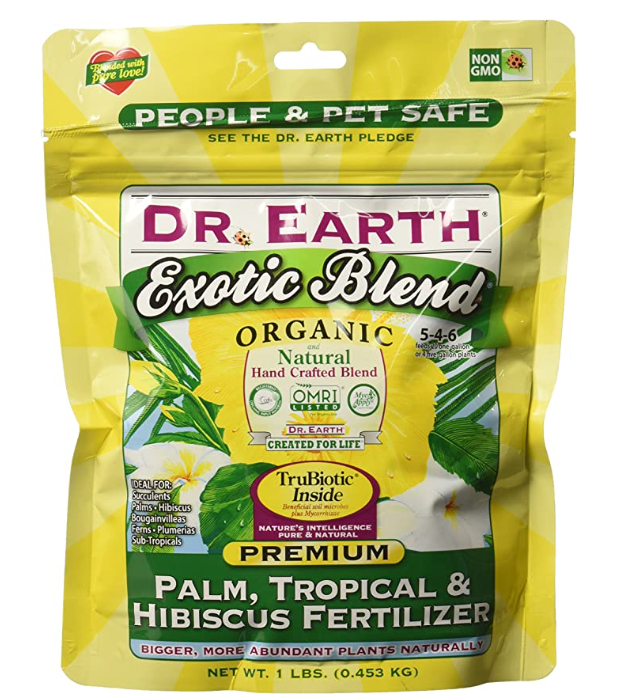
Dr. Earth's nutrient mix is the best fertilizer for palm trees needing an organic solution. It contains five major nutrients that promote growth and foliage health in palm trees, tropical plants, and hibiscus. These include nitrogen, phosphate, potash, sulfur, and magnesium.
The fertilizer is free of sewage sludge, GMOs, and chicken manure. You can apply it to new plantings before you plant. Or, add it to growing palms from early April to late August.
PROS
- Organic solution
- Major nutrients
- GMO free
CONS
- Not the greatest value for the money

Jobe's Organics granular fertilizer is a fact-acting palm fertilizer that works for all varieties. The USDA lists it for organic gardening as it contains no synthetic chemicals.
The fertilizer contains Jobe's Biozome, microorganism archaea that break down materials for quick results. It improves the plant's overall condition, fights against disease, and keeps palm trees thriving in drought conditions.
The fertilizer is available in 1.5lb and 4 lb variations. Opt for larger bags for palm trees since you’ll need three cups of fertilizer for trees with the largest fronds of 3 feet and up to eight cups for palms with five-foot fronds.
PROS
- Comes in easy to pour bag
- Proprietary archaea blend
- No synthetic ingredients
CONS
- Attracts pets, especially dogs
JR Peter's 51624 Jack's Classic is the best palm tree fertilizer to prevent salt buildup in the soil. It has an optimum nitrogen, phosphorus, sulfur, micronutrients, and potassium blend. The high potassium levels promote lush green growth in palm trees.
It works best for lady, majesty, kentia, queen, date, and royal plans. As for cycads, you can use the fertilizer for zamia and sago palms. As it's a water-soluble palm fertilizer, you don't have to worry about surface run-off.
While it’s one of the best palm plant foods, it’s more expensive than other fertilizers on the list.
PROS
- Contains micronutrients for lush growth
- Water soluble
- Ideal for tropical plants
CONS
- Slightly expensive
Grow More's palm tree fertilizer formula is based on Dr. Timothy K's recommendations. So, it has the right NPK ratio of six essential nutrients for palms and tropical plants. The fertilizer is highly soluble in water and does not wash away with watering.
You can use it for all types of palm trees growing in native soil or containers. Apply it once a month during active growing seasons. Decrease the application rate for young plants or when temperatures go below 65F.
PROS
- Foliar applications
- Works through soil drench application
- pH-balanced formula for native grown plants
CONS
- Can clump up if stored incorrectly
The Nelson Plant Food is the best fertilizer for palm trees, pampas grass, bananas, and fishtail. It is a blend of monoammonium phosphate, activated sludge, sulfur, magnesium sulfate, potassium nitrate, potassium sulfate, ferrous sulfate, and other nutrients.
The slow-release fertilizer has 90% nitrogen made available for the palm tree through microbial breakdown. It also contains elemental sulfur, creating a favorable soil environment for palm trees.
The fertilizer best suits Mexican Fan Palms, Palmetto, Mediterranean Fan, and Canary Island Palms. You can also use it for indoor palm trees throughout the growing season.
PROS
- Benefits of soil and trees
- Low salt and acidic
- Works for all palm varieties
CONS
- Doesn't work well on cycads
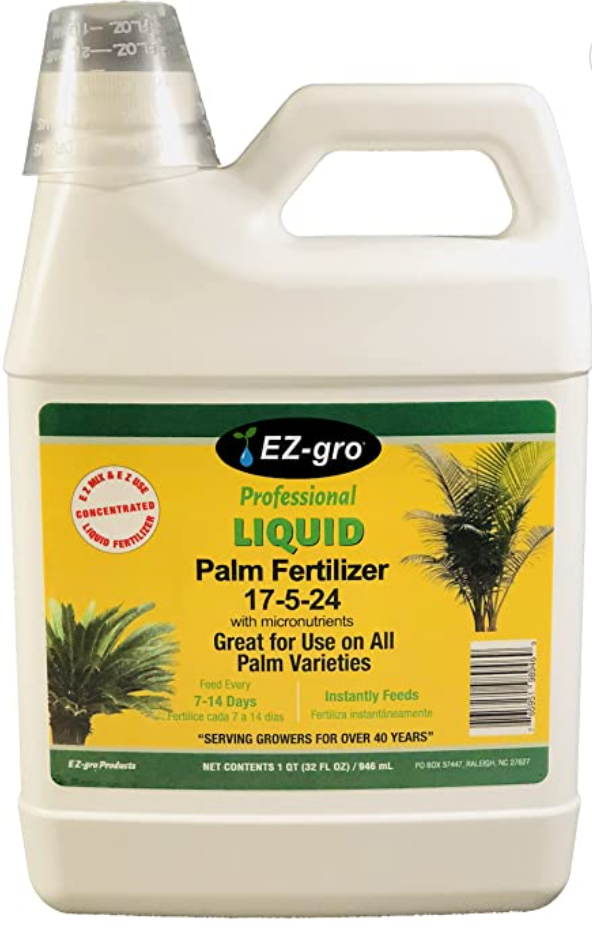
The Palm Fertilizer by E Z-GRO contains a higher-than-average amount of potassium and other nutrients to keep palm trees healthy. It's ideal for use when dark and cool growing conditions are prevalent.
The palm fertilizer is urea-free. So, it can be used in several climate and temperature conditions. Urea-free formulations also allow more nitrogen to seep into the soil. The pack comes with a free measuring cup for precise measurements.
PROS
- Contains micronutrient package
- Enhanced with extra sulfur and magnesium
- Ideal for dark growing conditions
CONS
- Only available in liquid form
Sweet New Earth Final Choice of the Best Palm Tree Fertilizer
In our opinion, the best fertilizer for palm trees is the Miracle-Gro Shake' N Feed Palm Plant Food. It is rich in several nutrients, including iron, magnesium, and manganese.
The best part about this palm fertilizer is that it feeds palm trees for three months. Being a slow-release fertilizer, it requires only four applications per year.
You can use it to fertilize palm trees, cycads, and tropical plants. It works just well in sandy soil as it does in clay soil. Its ingredients prevent the curling of palm fronds and the yellowing of leaves.
But are you a newbie to growing palm trees and having trouble measuring precise fertilizer amounts? The Jobe's Palm Spikes is a better option. The pre-measured palm fertilizer quantity prevents over-fertilization. Plus, it has all the nutrients your plant needs.
How We Chose the Best Fertilizer for Palm Trees
There's no shortage of palm tree fertilizers. From spikes and liquid to solid fertilizers, you'll be overwhelmed by the number of fertilizers.
A palm fertilizer can be categorized based on its concentration, nutrient content, and texture. Here are the four types of palm tree fertilizers based on their texture and form.
- Liquid
- Water soluble
- Granular
- Spikes
- NPK Ratio
- Inorganic vs. Organic
Liquid
Liquid fertilizers come in liquid form. You can apply them directly to the palm tree or mix them with water. Most liquid fertilizers contain nitrogen, potassium, and phosphorus.
Some also contain micronutrients, such as sulfur, calcium, and magnesium. Plants can easily absorb liquid fertilizers, getting a quick nutrient boost. Although they are popular in commercial agriculture, you can also use liquid fertilizers for home gardening.
Liquid fertilizers also allow precise applications. You can measure the amount in measuring cups to prevent over-fertilization. There are two main types of liquid palm fertilizers:
- Organic: These fertilizers are made from natural sources. For example, they may contain animal manure or compost.
- Synthetic: These are made of chemical compounds. Commonly used synthetic fertilizers include ammonium nitrate and urea.
When choosing between a liquid or granular fertilizer, you should consider the following:
- Salt Content: Granular fertilizers, especially synthetic ones, contain a high salt content. Roots of palm trees may steer away from granular fertilizer bands. Thus, you should use liquid fertilizers as starters and then proceed to granular ones.
- Spatial: Nutrients are more mobile in liquid fertilizers. So they can reach plant roots better than granular fertilizers.
- Consistency: Each drop of a liquid fertilizer has the same nutrient content. But in a granular fertilizer, every granule has individual nutrients. The nutrients from granules away from roots may not be able to reach the roots.
Water Soluble
Water-soluble fertilizers dissolve completely in water. They are easy to uptake by plants and mainly contain mineral salts. Some water-soluble fertilizers also contain trace elements needed for palm development.
Most gardeners use water-soluble fertilizers in a hydroponic system. In this system, nutrient-rich water is circulated around the plant roots.
The main advantage of water-soluble fertilizers is quick availability. Since they dissolve quickly, the nutrients are readily available for the palm tree.
These fertilizers work well for any kind of palm tree. But they are the best for palms used in landscaping. Some examples include:
- Areca Palm
- Bismarck Palm
- Coconut Palm
- Pygmy Date Palm
- Date Palm
If you plan to buy water-soluble fertilizers for your palm trees, note that they need frequent reapplications. You'll need to apply them every two weeks during the growing season.
Such fertilizers are most effective when you use them on moist soils. Dry soil lacks water and prevents nutrient absorption by plant roots.
Granular
Granular fertilizer is a palm tree food blend in the form of pellets. Most of these fertilizers are slow-release, which means they don't dissolve quickly.
Granular fertilizers are suitable for palm trees because they release nutrients slowly. As the pellets break down, the plants take up the nutrients.
Every granular fertilizer contains three essential nutrients; phosphorus, potassium, and nitrogen. Some varieties may also have additional micronutrients like iron and zinc.
Granular fertilizers are also available in several formulations for different palms. For example, some fertilizers are made for Areca palms, while others are meant for Coconut palms.
Granular fertilizers typically have the following:
- A longer shelf life than other fertilizers
- Slow-release capabilities, feeding the plant for a long time
- Minimal salt content, reducing the risk of root burn
Before choosing a granular palm tree fertilizer, we recommend testing your soil. You can use a soil testing kit to check your soil's pH and nutrient content.
Some granular fertilizers are acidic and may not be suitable for alkaline soils. You should choose a fertilizer with the right nutrient ratios to match the requirements of your palms.
If possible, go for organic options. They are made of natural materials, like blood meal, fish emulsions, or bone meal. Do note that they may not be quick-release and take longer to release nutrients.
Spikes
Palm fertilizer spikes are long and narrow spikes made using compressed nutrients. Instead of measuring the fertilizer, you have to insert the spike containing the pre-measured fertilizer quantity into the soil around the palm tree roots.
Ideally, the spike should be 8 to 10 inches deep in the soil. But you should follow the manufacturer's instructions for precise insertion.
The spikes release nutrients slowly into the soil over weeks or months. It helps maintain a steady supply of nutrients for plants.
To get the best results with this palm plant food, it's best to dig small holes around the tree. Insert the spikes into the palm's dripline. The line is the area directly beneath and around the palm's canopy.
When rain, water, or condensation falls on the plant, it will fall on the spikes. The water carries the nutrients to the roots of the palm trees.
Besides, the bacteria and fungus in the soil also break down the nutrients in these fertilizers. Since these microorganisms work slowly, the spikes release nutrients over three or more months.
When buying palm fertilizer spikes, check the ingredients properly. Some fertilizers may contain formaldehyde. It can be harmful to plants, soil microorganisms, and the environment.
Although spike fertilizers are convenient to use, they have the following drawbacks.
- Environmental Impact: If you do not insert the spikes properly, the nutrients may seep into the surface soil. These nutrients saturate the groundwater. They then run off into nearby water bodies, harming aquatic ecosystems.
- Uneven Distribution: There's a higher concentration of nutrients around the spikes than in other areas. So, the area near the spike may be over-fertilized.
- Limited Nutrient Variety: Most spike fertilizers only contain essential nutrients. They may lack trace or micronutrients that can help in palm tree growth and development.
NPK Ratio
NPK ratio in fertilizer is the ratio of nitrogen, phosphorus, and potassium in a fertilizer product.
There are many manufacturers making fertilizers. Similarly, there are many blends of nutrients, each made for different purposes.
But all fertilizers must have a uniform information system to help buyers compare products. NPK ratio is that information. It is short for:
- N: Nitrogen
- P: Phosphorus
- K: Potassium
K is the element symbol for potassium. It is used instead of 'P' because the letter is already used for phosphorus. Here are the roles of these nutrients in palm tree growth.
- Nitrogen: It is needed for leaf growth. Plants that contain a lot of leaves require a high concentration of nitrogen.
- Phosphorus: Plants need phosphorus for root development. It helps anchor the plants in the soil. Phosphorus also increases fruit production and results in a better bloom.
- Potassium: It fights off diseases and allows the plant to withstand extreme temperatures. Since palm trees are usually grown outdoors, potassium is essential for them.
The NPK ratio of a fertilizer shows the amount of these nutrients present in that blend. Suppose a fertilizer has an NPK ratio of 30-10-10. That means it has 30% nitrogen, 10% phosphorus, and 10% potassium.
Why use the NPK Ratio?
Plants need plenty of nutrients. Why should you choose a fertilizer based on these three nutrients? They are the primary macronutrients.
Plants use up to 17 nutrients to survive. Most of them are micronutrients and are needed in small quantities. Meanwhile, macronutrients are required in higher concentrations.
When looking for the best fertilizer for palm trees, you'll notice that most varieties have more nitrogen than other nutrients. It is due to leaching.
Irrigation and heavy rains remove nitrogen from the soil in a process called leaching. Since nitrogen moves freely, it becomes an easier target than other nutrients.
Fertilizers replenish the lost nitrogen. It is an important component of chlorophyll, the green pigment plants use for photosynthesis. Nitrogen also forms most plant amino acids, which later form proteins.
How to use the NPK Ratio?
To choose palm plant food with the right NPK ratio, you should know your plant's nutrient requirements. A study found that date palm trees need 700 grams of nitrogen for the best growth and fruit quality.
How do you calculate the amount of fertilizer you should look for? Suppose a fertilizer has an NPK ratio of 30-10-30 in a 2lb bag (907 grams).
Since 30% of 907 grams is nitrogen, the fertilizer contains 272 grams of nitrogen. That means you'll need 2.5 bags of this fertilizer to fulfill your plant's nitrogen needs.
700 grams / 272 grams = 2.5
NPK proves helpful when you have a general idea of the concentration of nutrients your plant needs. You can choose the best fertilizer for palm trees based on this information.
The ideal NPK for palm trees is 3: 1: 3. But you should conduct a soil test to understand the exact NPK needs of your palm.
Inorganic vs. Organic Fertilizer
The debate between organic and inorganic often arises when choosing the best fertilizer for palm trees. Some people may also make a homemade fertilizer using manure, compost, and other organic materials.
However, it's essential to know the difference between both types of fertilizers. It will help you make an informed decision on which palm plant food to choose.
Organic
Organic fertilizers are made using organic materials. Some of them are:
- Fish meal
- Bone meal
- Compost
- Manure
Organic fertilizers are generally more expensive than inorganic ones. They also release nutrients slower compared to their quick-release counterparts.
Common examples of organic fertilizers are guano, worm castings, and compost. Some home gardeners may also use seaweed and blood meal fertilizers for palm trees.
The main appeal of these fertilizers is that they are environmentally friendly. They do not contain harmful chemicals that could leach into groundwater or impact the ecosystem. Plus, they are made of renewable resources. This is why some people pick organic for the best fruit tree fertilizers.
It's best to use organic fertilizers on palm trees during the growing season. The general guideline is to apply them every three to four months.
Do note that the palm's growth stage will impact the nutrients it needs. For example, younger plants need more nitrogen since they are growing.
So, you should choose an organic palm fertilizer rich in nitrogen during this stage. Other benefits of using such a fertilizer are:
- Improvement in soil texture and structure
- Enhanced nutrient availability and soil fertility
- Promotion of soil microorganisms
- Improvement in soil water retention
However, organic fertilizers may smell stinky since they have animal excretions. Only use them for indoor palm trees if you're okay with the smell. Or, buy smell-free alternatives.
Inorganic
Some palm plants require fertilizers rich in micronutrients, such as iron and magnesium. Inorganic fertilizers provide these nutrients that organic fertilizers may not have enough of.
These fertilizers have the following benefits:
- Quick Results: Since inorganic fertilizers break down quickly, they promptly provide nutrients to plants. They result in the rapid growth of palm trees.
- Versatility: Inorganic fertilizers are available in different forms. Depending on your preferences, you can buy them as liquids, spikes, or powders.
- Customizability: Organic fertilizers do not allow customization of nutrient content. They contain only a limited amount of trace elements. In contrast, inorganic fertilizers will enable you to choose the right blend for your plant's needs and soil conditions.
- Long Shelf Life: While organic fertilizers may clump or spoil fast, inorganic fertilizers have a longer shelf life.
- Cost-Effectiveness: In general, inorganic fertilizers are cheaper than organic fertilizers. They're ideal for people who need palm fertilizer for a large tree or are on a budget.
The downsides of using inorganic fertilizers are:
- Possible Toxic Elements: Some may contain toxic elements, such as formaldehyde. You should read the ingredients before buying an inorganic fertilizer.
- Environmental Impact: Overusing these fertilizers can cause water and soil pollution. It may harm ecosystems, human health, and wildlife.
- Soil Health: Inorganic fertilizers may also alter the natural nutrient balance in the soil. It might reduce the soil's ability to support plant growth in the long term.
The best approach to choosing the right palm fertilizer is to consider the type of palm tree, soil conditions, and your budget. It also helps to consult an arborist or a professional gardener for more information.
FAQs

Carl Anderson is the main author of Sweet New Earth. He is an avid outdoors enthusiast who loves gardening. He spends his time reading, hiking and learning about new ways to optimize his garden. You can learn more about him here.

